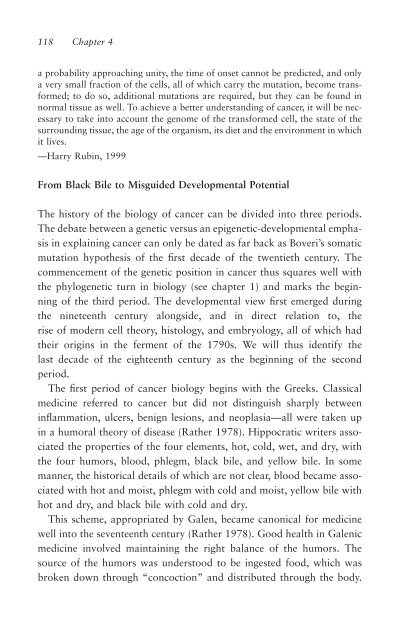A Critique of Pure (Genetic) Information
A Critique of Pure (Genetic) Information
A Critique of Pure (Genetic) Information
You also want an ePaper? Increase the reach of your titles
YUMPU automatically turns print PDFs into web optimized ePapers that Google loves.
118 Chapter 4<br />
a probability approaching unity, the time <strong>of</strong> onset cannot be predicted, and only<br />
a very small fraction <strong>of</strong> the cells, all <strong>of</strong> which carry the mutation, become transformed;<br />
to do so, additional mutations are required, but they can be found in<br />
normal tissue as well. To achieve a better understanding <strong>of</strong> cancer, it will be necessary<br />
to take into account the genome <strong>of</strong> the transformed cell, the state <strong>of</strong> the<br />
surrounding tissue, the age <strong>of</strong> the organism, its diet and the environment in which<br />
it lives.<br />
—Harry Rubin, 1999<br />
From Black Bile to Misguided Developmental Potential<br />
The history <strong>of</strong> the biology <strong>of</strong> cancer can be divided into three periods.<br />
The debate between a genetic versus an epigenetic-developmental emphasis<br />
in explaining cancer can only be dated as far back as Boveri’s somatic<br />
mutation hypothesis <strong>of</strong> the first decade <strong>of</strong> the twentieth century. The<br />
commencement <strong>of</strong> the genetic position in cancer thus squares well with<br />
the phylogenetic turn in biology (see chapter 1) and marks the beginning<br />
<strong>of</strong> the third period. The developmental view first emerged during<br />
the nineteenth century alongside, and in direct relation to, the<br />
rise <strong>of</strong> modern cell theory, histology, and embryology, all <strong>of</strong> which had<br />
their origins in the ferment <strong>of</strong> the 1790s. We will thus identify the<br />
last decade <strong>of</strong> the eighteenth century as the beginning <strong>of</strong> the second<br />
period.<br />
The first period <strong>of</strong> cancer biology begins with the Greeks. Classical<br />
medicine referred to cancer but did not distinguish sharply between<br />
inflammation, ulcers, benign lesions, and neoplasia—all were taken up<br />
in a humoral theory <strong>of</strong> disease (Rather 1978). Hippocratic writers associated<br />
the properties <strong>of</strong> the four elements, hot, cold, wet, and dry, with<br />
the four humors, blood, phlegm, black bile, and yellow bile. In some<br />
manner, the historical details <strong>of</strong> which are not clear, blood became associated<br />
with hot and moist, phlegm with cold and moist, yellow bile with<br />
hot and dry, and black bile with cold and dry.<br />
This scheme, appropriated by Galen, became canonical for medicine<br />
well into the seventeenth century (Rather 1978). Good health in Galenic<br />
medicine involved maintaining the right balance <strong>of</strong> the humors. The<br />
source <strong>of</strong> the humors was understood to be ingested food, which was<br />
broken down through “concoction” and distributed through the body.
















